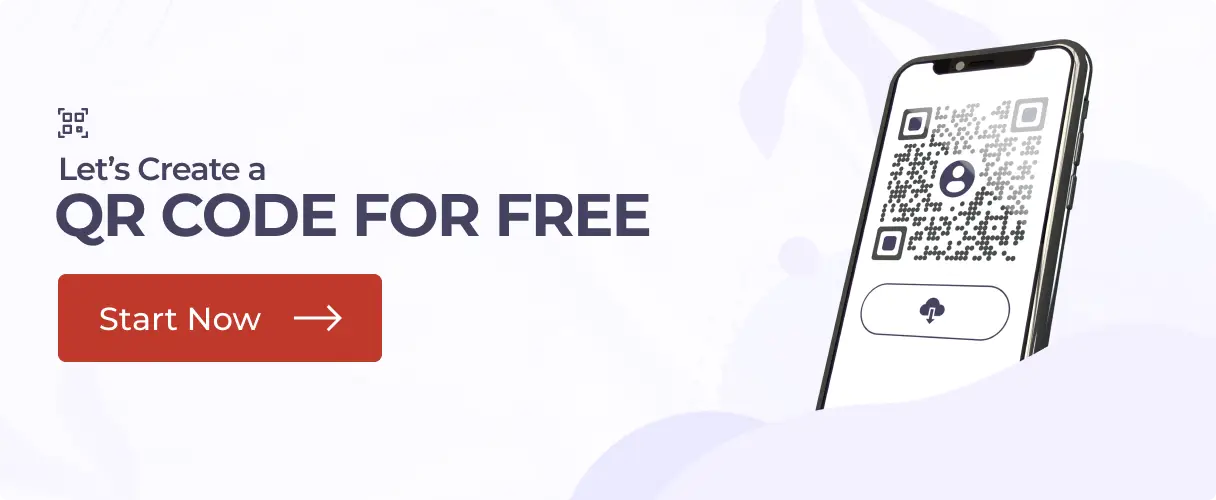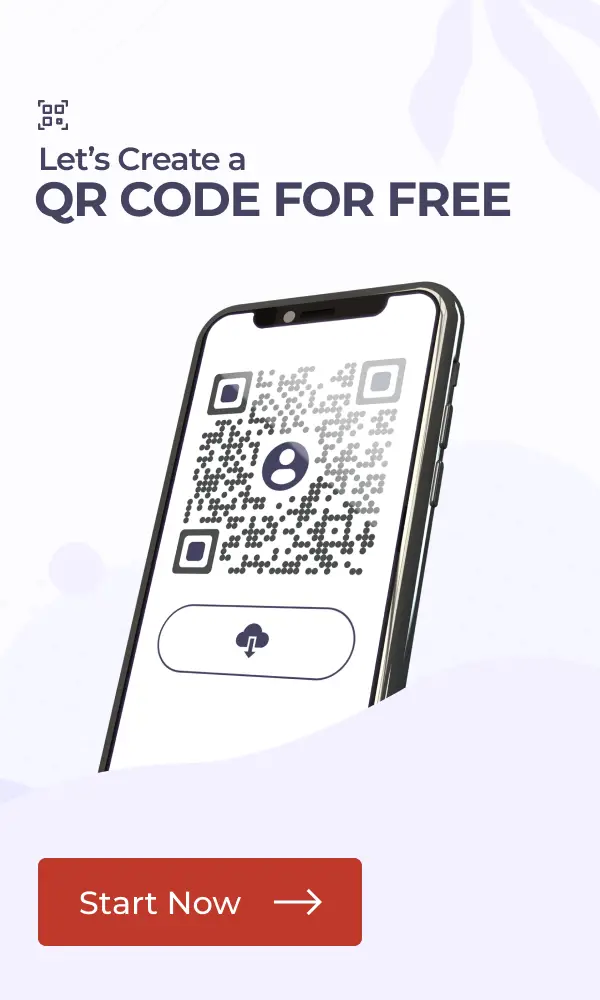Marketers and businesses all around the globe are actively using QR Codes.
They are, no doubt, powerful tools for connecting the offline world with the digital. However, creating and using QR Codes effectively requires following certain guidelines.
This article shall explore essential QR Code guidelines, including design tips, printing best practices, size requirements, and how to use them effectively.
Let’s begin!
A. Why do QR Code guidelines matter?

QR Codes are created with ease and speed of scanning in mind. This allows the user to access information as seamlessly as possible.
However, poor design or incorrect usage can sometimes compromise this simplicity. A user might try to scan your QR Code and find that it does not work.
That leads to frustration and a negative experience and does the opposite of what a QR Code is supposed to do for the users.
A poorly designed QR Code might have issues like low contrast, distorted shapes, or missing quiet zones, all of which make it hard for the scanners to read.
Also, printing errors, such as low resolution or improper sizing, can make your QR unresponsive. In fact, placing the code on hard-to-reach surfaces will make even the most elaborately designed QR Code dysfunctional.
Hence, proper QR Code design guidelines and QR Code printing guidelines will ensure that your QR Code remains functional and user-friendly.
After all, a well-designed QR Code is more than just scannable; it enhances the user experience, drives engagement, and helps you achieve your goals.
Whether it’s directing users to a website, sharing contact information, or enabling quick check-ins, a QR Code generated in the right manner can do wonders for your use case.
Pro Tip: Taking a little care while designing and printing your QR Code will go a long way in making it reliable-so it works flawlessly between devices and environments.
B. QR Code design guidelines
A good-looking QR Code can attract attention without losing functionality. Here’s how to design QR Codes effectively:
1. Don’t over-customize
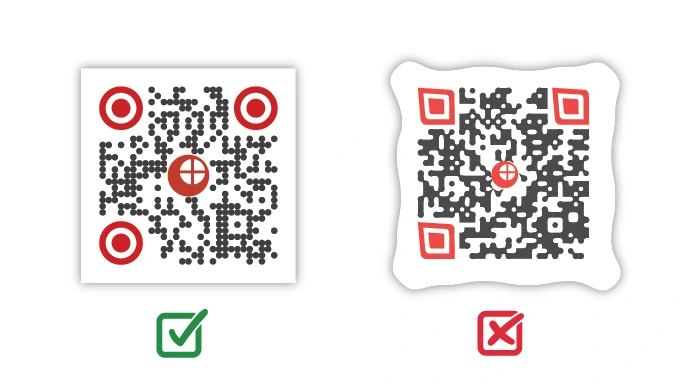
What’s really catchy about QR Code tech is that you can customize QR Codes by color, logos, or patterns (especially the dynamic QR Codes).
Customizing the QR Codes can make them blend well with your brand and make them attractive.
However, over-customizing the QR Codes can sometimes make them dysfunctional. So, you always need to find a balance between creativity and scannability.
For instance, there must be a clear contrast between the background of the QR Code and its foreground.
Make sure you use dark colors for the QR Code patterns and light backgrounds (think black QR Code on white background or white QR Code on black background) so that scanners can easily detect and read the code.
Avoid blending colors or using gradients that might obscure the QR Code modules.
Also, while adding a logo enhances branding, you need to make sure it does not cover or distort the essential elements of the QR Code (data patterns, QR Code eyes, etc).
2. Don’t stretch it
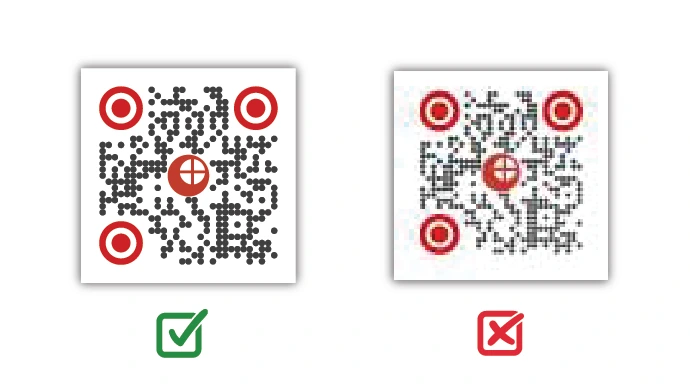
A QR Code’s scanning ability mostly depends on its clear and square shape and its crisp resolution.
The deformation in terms of shape or quality, whether stretched, skewed, or shaped otherwise, can make them unusable by scanners.
The general idea is that resizing a QR Code to fit a particular area can distort the modules enough to make them unusable.
When resizing a QR Code, always maintain its original proportions. If you need to adjust its size, scale it uniformly so the square shape remains intact.
Keeping the QR Code’s geometry precise ensures its functionality and makes it easy for users to scan.
Pro Tip: For every 10 cm of distance to the code, add an extra 1 cm to the length and width of the code. For example, if you expect users to scan it from a 10 cm distance, the code should be at least 1 cm x 1 cm; similarly, if users are likely to scan it from around 50 cm distance, then the code should be at least 5 cm x 5 cm in size.
3. Always include a quiet zone
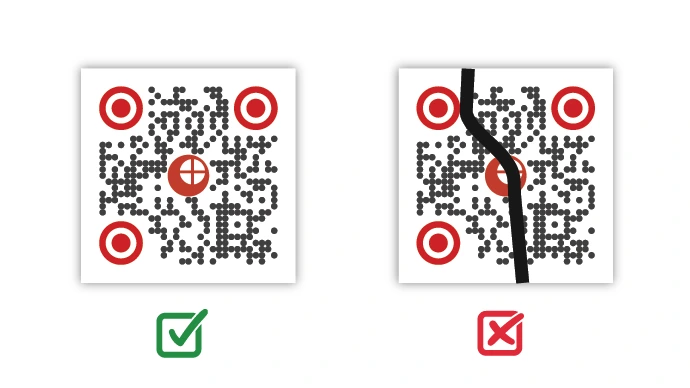
A quiet zone is essential but the most overlooked part of QR Code design. A quiet zone is basically the empty space that surrounds the QR Code and works as a cushion to differentiate the code from the surrounding background.
In cases where a quiet zone doesn’t exist, the QR Code might merge into its background, and scanners can fail to detect it.
The quiet zone should be at least four modules (the smallest square within the QR Code) wide on all sides.
For example, if your QR Code’s modules are 2 mm, the quiet zone should be at least 8 mm.
Pro Tip: You are more likely to have your QR Code recognized and scanned rapidly in a busy or cluttered environment by having an adequate quiet zone.
4. Add a Call-to-Action (CTA)
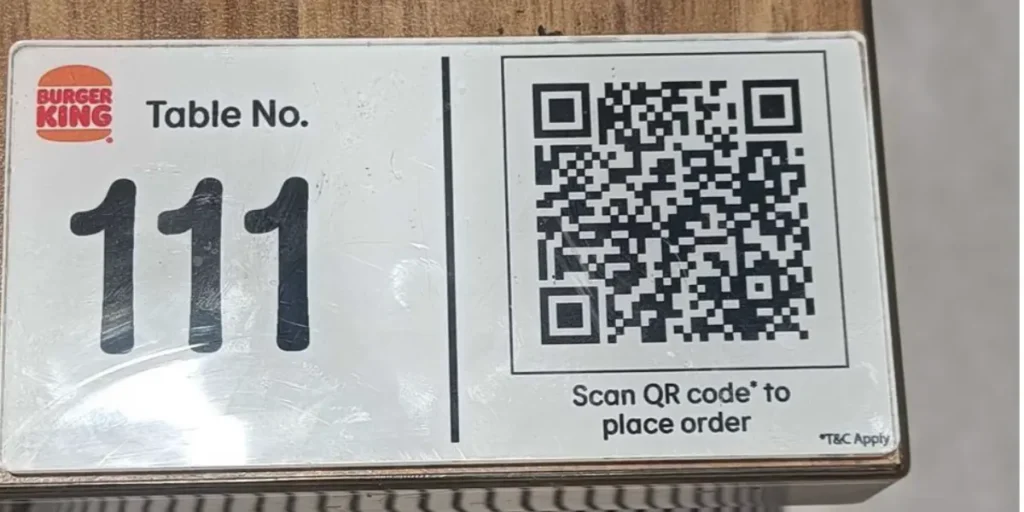
Your QR Codes are most effective when the users know what they’ll get after scanning. A clear and engaging call-to-action removes any underlying confusion and encourages the user to interact with the code.
Simple phrases like “Scan to Order,” “Scan for a Discount,” or “Scan to Learn More” provide context and set expectations.
Without a CTA, the user might simply look right past the QR Code and have no idea what to do with it.
Also, a well-placed CTA always draws in more attention and enhances engagement. You can position your CTA above, below, or next to the QR Code.
You can combine this with other visually appealing elements, such as an arrow or graphic, for enhanced effect.
Author’s note: Keep your CTA short, action-oriented, and relevant to your audience for maximum impact. The right CTA can significantly increase QR Code engagement.
Here are some quick ideas:
- Offer Rewards: “Scan to Get 20% Off!” or “Unlock Your Reward!”
- Build Curiosity: “Discover More—Scan Now!” or “What’s Inside? Scan to See!”
- Create Urgency: “Limited Time Offer—Scan Today!”
- Encourage Interaction: “Take the Quiz—Scan Here!” or “Play to Win!”
- Simplify Access: “Scan to Download!” or “Get Directions Now!”
What you learned:
- Don’t Over-Customize: Keep the balance between creativity and scannability. Use contrasting colors and avoid excessive design elements that hinder functionality.
- Maintain Shape & Size: Never stretch or distort QR Codes. Keep them square and scale proportionately for optimal scanning.
- Add a Quiet Zone: Surround your QR Code with empty space (at least 4 modules wide) to ensure scanners can easily detect it.
- Include a Call-to-Action (CTA): Tell users what they’ll get by scanning. CTAs like “Scan to Order” or “Get 20% Off!” increase engagement.
By following these tips, your QR Codes will not only be professional-looking but also deliver reliably.
These small things—contrast, proportions, quiet zones, and CTAs—make a big difference in delivering the best user experience possible with your QR Code.
Now that you know what to keep in mind while designing the QR Code, let’s take a look at some best practices for printing it. Keep reading.
C. QR Code printing guidelines
Printing a QR Code sounds simple, but it involves attention to detail to make it scan perfectly.
Printing a poorly designed QR Code can be the death knell of even the most well-designed QR Code.
1. Choose good quality print
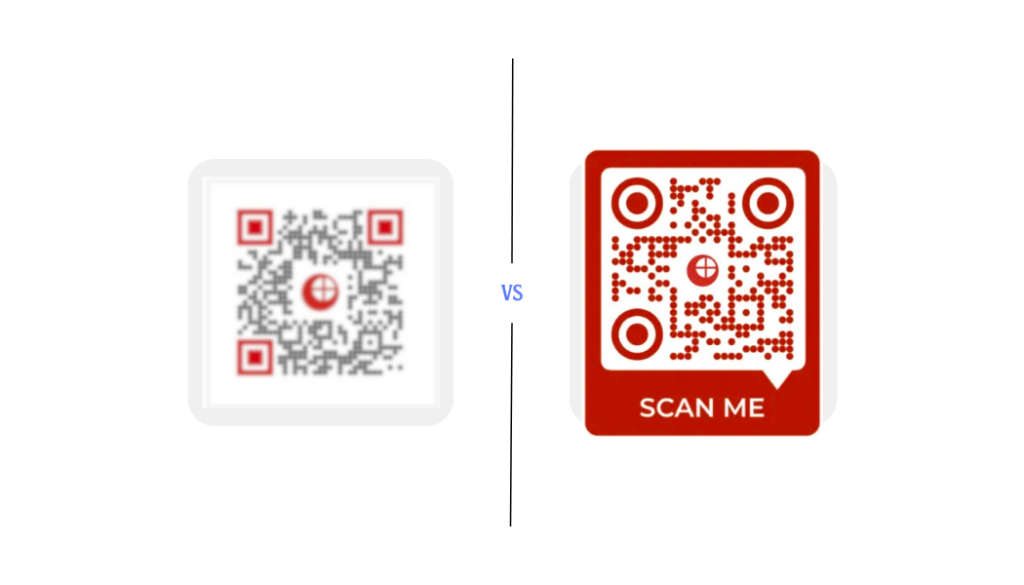
The resolution of a printed QR Code has a lot to do with scannability. Printing at low resolution will result in a blurry or pixelated QR Code, which means that a scanner would not read it.
It’s best to use high-resolution images for printing QR Codes, especially for larger formats, such as posters or billboards.
Pro Tip: Whenever possible, work in vector file formats like SVG, EPS, or PDF so the QR Code will always appear sharp at any size set.
2. Material selection
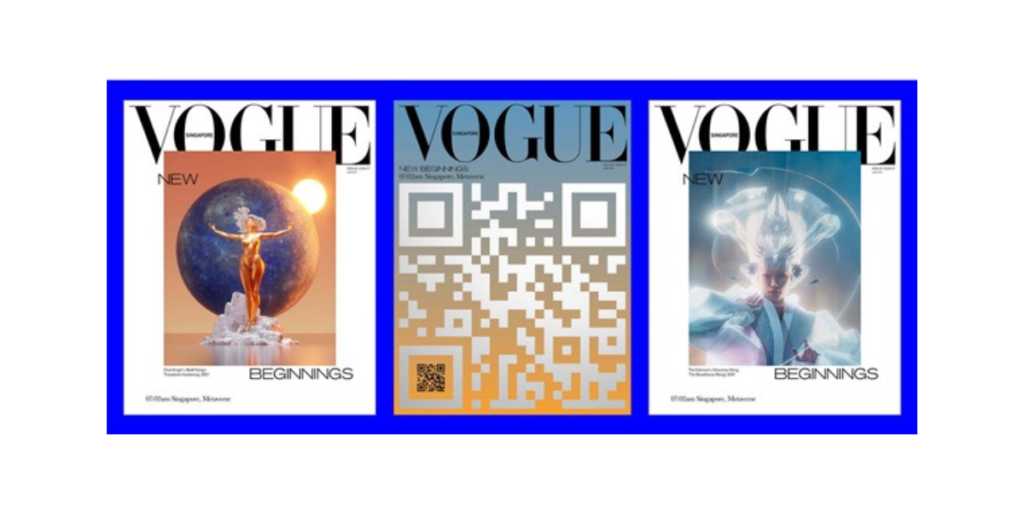
The material on which the QR Code is going to be printed on will affect how usable the QR Code is.
To be safe, opt for smooth, non-reflective surfaces that do not distort the code for optimal scanability.
Shiny materials can cause glare under certain lighting conditions. This can hinder with the scanning ability.
If you must print using shiny or reflective materials, then make sure that your QR Code is in high contrast and test it in different lighting environments.
If printing outdoors, consider using weather-resistant materials so that your QR Code stays intact and readable under any condition.
3. Choose the right QR Code placement
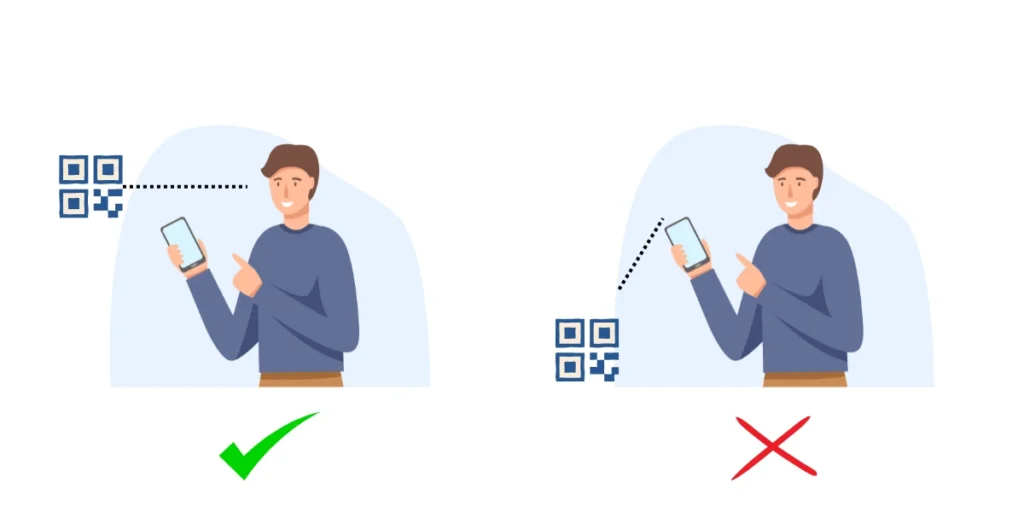
The usefulness of a QR Code is determined by the location from which it can be immediately and comfortably scanned.
- Avoid Corners or Folded Areas: If you ever put a QR Code inside the packaging on a corner fold or seam, then you’re likely scaring off its scanning ability from distortion. Corners face the most wear and tear. Think for the long run.
- Place at Eye Level on Posters: For posters, position the QR Code at eye level so users can easily notice and scan it without having to bend or stretch.
- Ensure Accessibility: Don’t place QR Codes in hard-to-reach areas, such as near the floor or in awkward positions on large packaging. Remember, QR Codes are supposed to make interaction more convenient and not harder.
Pro Tip: If you’re printing QR Codes for physical products, always test their scannability after printing and packaging to avoid surprises.
What you learned:
- Use High-Quality Prints: Always print QR Codes in high resolution to avoid blurriness. For the best results, use vector file formats like SVG, EPS, or PDF to ensure sharpness at any size.
- Pick the Right Material: Choose smooth, non-reflective materials for better scanability. For outdoor use, opt for weather-resistant materials. Test reflective surfaces under different lighting conditions if needed.
- Smart Placement: Avoid corners or folded areas on packaging. For posters, place the QR Code at eye level. Make sure the QR Code is in easily accessible and visible spots for effortless scanning.
D. QR Code minimum size
While working within the QR Code industry, one of the most common questions I’ve heard time and again is, “How small can a QR Code be?”
While QR Codes can be scaled down, their size matters for scannability.
1. Minimum size for QR Code

The standard minimum size for a QR Code is: 1 x 1 inch (2.5 x 2.5 cm). So, as long as it is that large, it will read just fine from a distance of about 1 foot or 30 cm.
Still, for bigger scanning distances or more complex QR Codes, it is necessary to increase the size accordingly. Here is a general guideline:
- 10:1 Rule: The size of your QR Code should be at least 1/10th of the scanning distance. For example, If users will scan your QR Code from 10 inches away, it should be at least 1 inch wide.
If the scanning distance is 5 feet (60 inches), the QR Code should be at least 6 inches wide.
2. Factors affecting the minimum size of a QR Code
While 1 x 1 inch is a great starting point, there are several other factors that can influence how big your QR Code should be:
I. Scanning distance
The farther away a user is from the QR Code, the larger it must be. Smaller QR Codes only work well if users can get up close to them, such as on product labels or business cards.
- Close Range: For QR Codes scanned from a few inches away, like on business cards or brochures, 0.8 x 0.8 inches may be sufficient.
- Long Range: For posters, billboards, or signage intended to be scanned from several feet away, the QR Code needs to be much larger to accommodate the distance.
II. Data density
More complex QR Codes with information, such as URLs, contact details, or links to multimedia, contain more modules (those little squares that compose the QR Code).
The complexity and size are more likely to cause the code to be too big to keep scannable.
- Low Data: A short URL for a QR Code can easily be kept smaller without affecting its scannability.
- High Data: A QR Code with vCard details or long URLs has to be larger to prevent it from looking blurry or causing scanning failure
E. Actionable tips on how to use a QR Code
QR Codes can make tasks easier and create a better user experience. It’s important to:
1. Link to relevant content
Make sure your QR Code links to content that adds value, such as:
- Website or landing page.
- Product manual or video tutorial.
- Social media profile.
2. Always test before publishing
Scan your QR Code on multiple devices to confirm it works as intended.
3. Keep it simple
Avoid embedding excessive data, and wherever possible, try using short URLs or dynamic QR Codes to make scanning faster.
F. Advanced tips for optimal QR Code design and printing
If you’re looking to optimize your QR Codes further, consider these tips:
1. Choose dynamic QR Codes over static
Dynamic QR Codes enable you to edit or update the linked content without needing to print the code again. This makes them ideal for campaigns with ever-changing information or seasonal promotions.
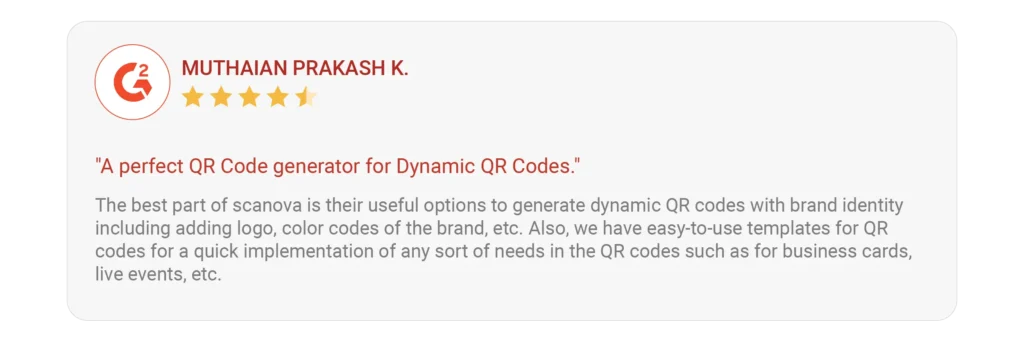
2. Test in different environments
Scan your QR Code at various distances and under different lighting conditions. Ensure it works under any condition.
3. Utilize Analytics
Keep track of scans for your QR Codes by monitoring its engagement analytics. Most QR Code generators like Scanova have integrated analytics at very affordable prices.

G. Some common challenges people face while scanning QR Codes
- Poor Contrast: Light-colored codes on light backgrounds are hard to scan.
- Tiny Sizes: If the code is too small, users will struggle to scan it.
- Multiple QR Codes in one place: This confuses users and scanning devices.
Instead, opt for a custom QR Code that links to a landing page with all your important information, like social media links or contact details. One QR Code, endless possibilities!
H. Bonus QR Code guidelines for specific use cases
QR Codes are versatile, but different use cases may require special considerations:
1. Event Tickets and Check-ins: For tickets, make sure your QR Code is safe and takes users to a reliable platform.
Pro Tip: Try Ticket Generator, your one-stop event ticketing and management tool by Scanova

2. Product Packaging: Place your QR Codes in a visible position that does not overshadow your product’s branding.
3. Restaurant Menus: Ensure your QR Code leads to a mobile-friendly digital menu.
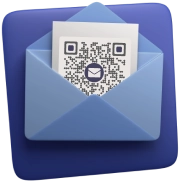

Conclusion
All of the above QR Code rules mean that your codes will work and be exciting to engage with.
Now that you know the guidelines for QR Code design, printing best practices, and size recommendations, you’ll be able to design the best codes that do not ruin the user experience.
Create the best quality QR Codes using Scanova’s easy QR Code generator. It’s free, reliable, and perfect for every use case.


